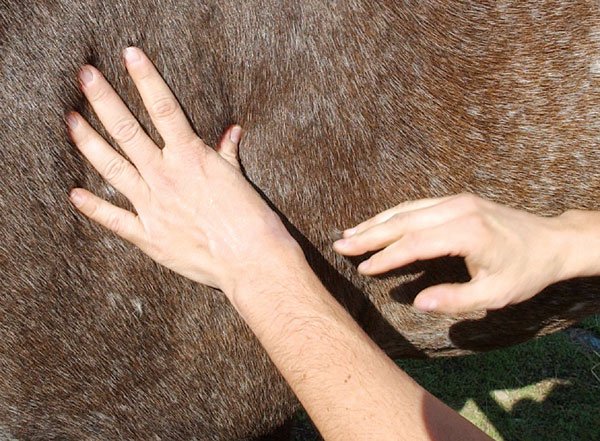Quin leans into the pressure a masseuse applies to his neck, his
glazed eyes half closed with pleasure. The skilled hands proceed
down his back, finding the tense spots he’s created at work and the
sore places from his afternoons at play. He sighs with deep
contentment that resonates through the wash rack, rattling the
crossties with a tiny bobble of his head as he closes his eyes.
Quin leans into the pressure a masseuse applies to his neck, his glazed eyes half closed with pleasure. The skilled hands proceed down his back, finding the tense spots he’s created at work and the sore places from his afternoons at play. He sighs with deep contentment that resonates through the wash rack, rattling the crossties with a tiny bobble of his head as he closes his eyes.
“A lot of the horses fall asleep,” said Julie Boegner, an equine sport masseuse who has titled her practice Nicker Kneads. “They talk … they tell you pretty clearly what they want with their bodies. If they really like something they’ll lean into it or close their eyes. If they flinch or pull away, that’s an area where they’re hurting and you need to take a closer look.”
Equissage, while still a fairly new practice among most horse owners, is rapidly gaining in popularity. It follows on the heels of chiropractic applications that have revolutionized the horse world.
Breeders on the competitive trail riding and show circuits are reaping the benefits of greater comfort, better performance and extended careers for their investments. While chiropractic work can put a horse’s back in place, massage can actively refine both movement and behavior.
“A lot of movement problems are compensatory,” said Boegner, a former multi-media producer who changed careers last summer after falling victim to corporate layoffs. She now operates from Woodmyst stables in Gilroy. “If they have an injury or even a small tear in the muscle, they’ll compensate. Over time that injury will heal, but the side they favor will have grown stronger, so they continue using that side and it begins to develop things unevenly. It’s like being right- or left-handed.”
While a single-side dominance may be acceptable in humans, it slowly builds stress in our four-footed friends. Think of the horse as a coffee table: If one leg is shorter or heavier, that imbalance will eventually affect the entire frame. Stresses that can exacerbate otherwise minor aches and pains include poor saddle fit, medical problems or difficult working conditions (various disciplines require things like a high head set or strong foot action).
Kelly Childers’ horse, DJ, began bucking and rearing, attempting to throw her after Childers inadvertently purchased a poorly fitted saddle for the 15-year-old Appaloosa-Thoroughbred mix. While scouring the Internet for answers to his behavior problem, she ran across a site on equissage in 2001.
“It sounded kind of crazy, but I figured I could take a week off and go through the class,” Childers said. “I started working on DJ and within a week he had stopped bucking, stopped rearing … I got my horse back.”
A former clinical research biologist, Childers started KC Equine Massage to help others achieve the level of comfort her horse found. She massages rehabilitative and maintenance horses, but frequently uses the process to “gentle” horses, or introduce them to human touch and handling. She also takes on project horses rescued from abusive homes, like Parker, a chestnut gelding.
“At first he didn’t want me to touch him, but by the time I got to his back he was just so relieved that his nose started running, which is a way horses release toxins and something that happens when they release a lot of pent-up tension,” said Childers. “He just sort of melted.”
Said Boegner, “Horses have the ability to hold tension for years. I doubt they’re preoccupied by it, standing out in their pasture going, ‘I’m really stressed out right now,’ but obviously horses worry, too. Cribbing (a behavior where a horse gnaws on things, stretching their esophagus and sucking wind), swaying and pacing are all signs of that.”
Boegner checks for signs of stress and takes a thorough account of the horse’s work schedule, injury history and play preferences before she goes to work. Jumpers will often carry tension in their gluteal muscles and rear legs, while English pleasure and driving horses are more likely to need some extra rubs in the neck and chest due to the high head set that they maintain in the arena.
Safety is always a primary concern for the masseuse, too. Both Childers and Boegner prefer to massage in a horse’s comfort zone when possible, remaining in the stall rather than taking them out to a hitching post. Horses have about 600 pairs of working muscles, so the average massage will take between 90 and 120 minutes, but a first-time client or a horse who hasn’t been seen in more than three months generally requires around three hours of work.
“For such large animals they’re surprisingly tender,” said Boegner. “When I massage my husband’s shoulders I have to use about five times the amount of pressure I do on a horse.”
The average massage will run first-timers around $90, but a monthly maintenance massage, at $70, is fairly equivalent to the cost of a private riding lesson, and keeping up with treatments can help to reduce vet bills in the future. Masseuses may not be medically trained, but they are often used to help pinpoint the source of a horse’s discomfort, saving time and money on exploratory measures.
For more information, visit www.KCEquineMassage.com or www.NickerKneads.com. To schedule an appointment, call Childers at (408) 842-0609 or Boegner at (408) 839-2286.












